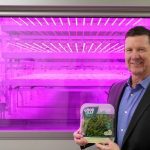Vertical, indoor farms have generated hype and have bee touted for their ability to reduce Canadian reliance on U.S. produce imports, but checking financial boxes has been an issue


Vertical, indoor farms have generated hype and have bee touted for their ability to reduce Canadian reliance on U.S. produce imports, but checking financial boxes has been an issue

Vertical farming has garnered significant interest as a food security solution in remote areas

Many perspectives will contribute to food production’s path forward

The development and future of vertical ‘plant factories’

Company touts their approach for sustainable, efficient indoor food production

A computer-controlled farm, on-site research and fresh produce are providing ways to combat diabetes in this northern community
It sits behind the wall that holds the community centre’s bingo board — and its name is Bertha. This ‘Smart Farm’ is Stephanie Cook’s domain on Opaskwayak Cree Nation (OCN), more than 600 kilometres northwest of Winnipeg. After more than six years of farming, Cook can walk into the room and smell if something is